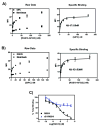Use of flow cytometric methods to quantify protein-protein interactions
- PMID: 20069525
- PMCID: PMC2849137
- DOI: 10.1002/0471142956.cy1311s51
Use of flow cytometric methods to quantify protein-protein interactions
Abstract
A method is described for the quantitative analysis of protein-protein interactions using the flow cytometry protein interaction assay (FCPIA). This method is based upon immobilizing protein on a polystyrene bead, incubating these beads with a fluorescently labeled binding partner, and assessing the sample for bead-associated fluorescence in a flow cytometer. This method can be used to calculate protein-protein interaction affinities or to perform competition experiments with unlabeled binding partners or small molecules. Examples described in this protocol highlight the use of this assay in the quantification of the affinity of binding partners of the regulator of G-protein signaling protein, RGS19, in either a saturation or a competition format. An adaptation of this method that is compatible for high-throughput screening is also provided.
Figures




Similar articles
-
Polyplexed flow cytometry protein interaction assay: a novel high-throughput screening paradigm for RGS protein inhibitors.J Biomol Screen. 2009 Jul;14(6):610-9. doi: 10.1177/1087057109336590. Epub 2009 Jun 16. J Biomol Screen. 2009. PMID: 19531661 Free PMC article.
-
Identification of small-molecule inhibitors of RGS4 using a high-throughput flow cytometry protein interaction assay.Mol Pharmacol. 2007 Jan;71(1):169-75. doi: 10.1124/mol.106.028670. Epub 2006 Sep 29. Mol Pharmacol. 2007. PMID: 17012620
-
Recognition of decay accelerating factor and alpha(v)beta(3) by inactivated hantaviruses: Toward the development of high-throughput screening flow cytometry assays.Anal Biochem. 2010 Jul 15;402(2):151-60. doi: 10.1016/j.ab.2010.03.016. Epub 2010 Apr 2. Anal Biochem. 2010. PMID: 20363206 Free PMC article.
-
Cell-based screening using high-throughput flow cytometry.Assay Drug Dev Technol. 2011 Feb;9(1):13-20. doi: 10.1089/adt.2010.0308. Epub 2010 Nov 4. Assay Drug Dev Technol. 2011. PMID: 21050072 Free PMC article. Review.
-
Identification of ligands targeting RGS proteins high-throughput screening and therapeutic potential.Prog Mol Biol Transl Sci. 2009;86:335-56. doi: 10.1016/S1877-1173(09)86011-0. Epub 2009 Oct 7. Prog Mol Biol Transl Sci. 2009. PMID: 20374721 Review.
Cited by
-
Broad ranges of affinity and specificity of anti-histone antibodies revealed by a quantitative peptide immunoprecipitation assay.J Mol Biol. 2012 Dec 14;424(5):391-9. doi: 10.1016/j.jmb.2012.09.022. Epub 2012 Oct 2. J Mol Biol. 2012. PMID: 23041298 Free PMC article.
-
Conformational dynamics of a regulator of G-protein signaling protein reveals a mechanism of allosteric inhibition by a small molecule.ACS Chem Biol. 2013 Dec 20;8(12):2778-84. doi: 10.1021/cb400568g. Epub 2013 Oct 24. ACS Chem Biol. 2013. PMID: 24093330 Free PMC article.
-
Biomarker discovery by novel sensors based on nanoproteomics approaches.Sensors (Basel). 2012;12(2):2284-308. doi: 10.3390/s120202284. Epub 2012 Feb 16. Sensors (Basel). 2012. PMID: 22438764 Free PMC article. Review.
-
Binding of human nucleotide exchange factors to heat shock protein 70 (Hsp70) generates functionally distinct complexes in vitro.J Biol Chem. 2014 Jan 17;289(3):1402-14. doi: 10.1074/jbc.M113.521997. Epub 2013 Dec 5. J Biol Chem. 2014. PMID: 24318877 Free PMC article.
-
Dectin-1 stimulating β-glucans inhibit Chlamydia infections both in vitro and in vivo.Pathog Dis. 2025 Jan 30;83:ftaf002. doi: 10.1093/femspd/ftaf002. Pathog Dis. 2025. PMID: 39886876 Free PMC article.
References
-
- Sarvazyan NA, Remmers AE, Neubig RR. Determinants of gi1alpha and beta gamma binding. Measuring high affinity interactions in a lipid environment using flow cytometry. J Biol Chem. 1998;273(14):7934–40. - PubMed
-
- Simons PC, et al. Ligand-receptor-G-protein molecular assemblies on beads for mechanistic studies and screening by flow cytometry. Mol Pharmacol. 2003;64(5):1227–38. - PubMed
-
- Sklar LA, et al. Flow cytometric analysis of ligand-receptor interactions and molecular assemblies. Annu Rev Biophys Biomol Struct. 2002;31:97–119. - PubMed
-
- Roman DL, et al. Identification of small-molecule inhibitors of RGS4 using a high-throughput flow cytometry protein interaction assay. Mol Pharmacol. 2007;71(1):169–75. - PubMed
Publication types
MeSH terms
Substances
Grants and funding
LinkOut - more resources
Full Text Sources
Molecular Biology Databases

